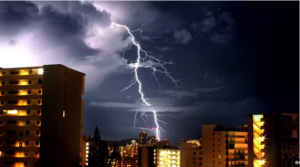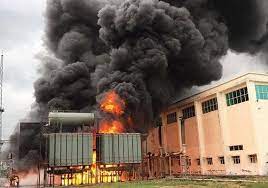
Electrical surges (transients), are sudden and brief duration increase of voltages in power systems. Transients can reach amplitudes of tens of thousands of volts. They cover a wide range of events like transients, glitches, over voltages (swells), harmonics etc.
They are common problems in facilities, leading to equipment degradation, disruption, damage, downtime, and even fire hazards.
Identifying the culprits behind these voltage disturbances are crucial in preventing future occurrences.
What are they?
The 7 common causes of electrical surges in facilities are:
1. Lightning strikes.

Lightning is a powerful source of electrical surges. When lightning strikes near a facility, the electrical energy can travel through power lines, communications and data lines, or even the ground causing a surge that can damage equipment.
2. Power grid fluctuations.

Problems with the power grid, such as voltage fluctuations or sudden power outages, can result in electrical surges when the power is restored. These surges damage sensitive equipment.
3. Faulty wiring or grounding.

Poorly installed or outdated electrical wiring can cause electrical surges. Loose connections, frayed wires, or faulty grounding can lead to sudden spikes in voltage.
4. Faulty appliances or equipment.

Malfunctioning appliances or equipment within the facility can cause electrical surges. Short circuits, power supply issues, or component failures can lead to sudden voltage spikes.
5. Utility operations.

Maintenance or repairs conducted by electric utilities on power lines or transformers can result in electrical surges. When power is restored after maintenance, a surge may occur, potentially causing damage to connected equipment.
6. Power factor correction.

Power factor correction devices are commonly used to improve energy efficiency. However, if not properly installed or maintained, they can cause electrical surges.
7. Switching on or off heavy electrical equipment.

Certain equipment, such as motors, compressors, or large machinery are inductive or capacitive loads, cause electrical surges when they starting or shutting down. They draw starting current up to 6X the steady state current injecting surges, known as inrush currents that can be damaging to other equipment connected to the same power source.
To prevent electrical surges in facilities, it is critical to be proactive in implementing protective measures such as surge protectors, voltage regulators, and grounding systems. Regular maintenance and inspections of electrical systems can also help identify and address potential issues before they cause surges.
@ Fullspectrum, we understand surge and power quality solutions and are uniquely positioned to offering costs effective solutions for all applications, to international codes & best practices.
For decades our solutions have been enhancing reliability, efficiency and overall general competitiveness of businesses across industries without borders.

Call and book a free survey today!


Victor Oyedu, FNSE, FNIEEE, CPQ.
Power Quality and Energy Management Specialist.
Publisher at Afrienergyonline.com
CEO, FullSpectrum Energy Solutions Limited, Nigeria.







